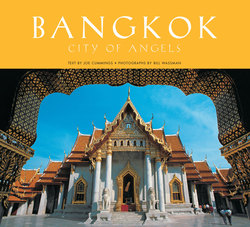Читать книгу Bangkok: City of Angels - Joe Cummings - Страница 7
ОглавлениеHISTORIC BANGKOK
“One early morning we steamed up the innumerable bends, passed the shadow of the great gilt pagoda, and reached the outskirts of town. There it was, spread largely on both banks, the oriental capital which had yet suffered no white conqueror.”
– Joseph Conrad
Thais gather at Wat Rajapradit to celebrate the Loi Krathong festival. Wat Rajapradit was founded in 1864.
Situated at the mouth of the kingdom's greatest river, and surrounded by the world's largest rice-producing cache, Bangkok serves as Thailand's nerve center, the quintessential primate city where the vast bulk of the country's wealth is concentrated.
That wealth, as well as the city's political and cultural identity, originally took shape 86 kilometers (53 miles) upriver in Ayuthaya, which served as the royal capital of Siam—as Thailand was then known—from 1350 to 1767. Encircled by rivers with access to the Gulf of Thailand, Ayuthaya flourished as a seaport courted by Dutch, Portuguese, French, English, Chinese and Japanese merchants. By the end of the 17th century the city’s population had reached one million and Ayuthaya had become one of the wealthiest and most powerful cities in Asia. Virtually all foreign visitors claimed it to be the most illustrious city they had ever seen, beside which London and Paris paled in comparison.
This 15th-century stupa (chedi in Thai), a depository for sacred Buddhist objects, typifies of the Ayuthaya style with its elongated, ribbed spire and slender reliquary dome.
“Among the Asian nations,” wrote London visitor Engelbert Campfer, “the Kingdom of Siam is the greatest. The magnificence of the Ayuthaya Court is incomparable.”
Throughout four centuries of Ayuthaya reign, several European powers tried without success to establish colonial relationships with the kingdom of Siam. An Asian power finally subdued the capital when the Burmese attacked in 1765, destroying most of Ayuthaya's Buddhist temples and royal edifices. Many Siamese were marched to Pegu, where they were forced to serve the Burmese court.
Four years after this devastating defeat at the hands of the Burmese, the Siamese regrouped under Phaya Taksin, a half-Chinese, half-Thai general who decided to move the capital farther south along the Chao Phraya River, closer to the Gulf of Siam. Thonburi Si Mahasamut, founded two hundred years earlier by a group of wealthy Thais who had turned it into an important trade entrepôt during the height of Ayuthaya's power, was a logical choice.
